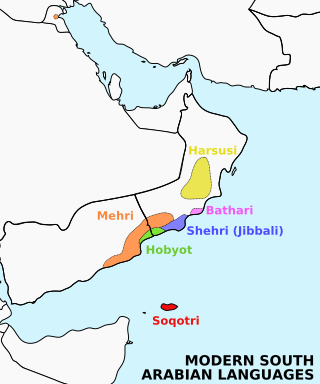Related Research Articles

The Cushitic languages are a branch of the Afroasiatic language family. They are spoken primarily in the Horn of Africa, with minorities speaking Cushitic languages to the north in Egypt and Sudan, and to the south in Kenya and Tanzania. As of 2012, the Cushitic languages with over one million speakers were Oromo, Somali, Beja, Afar, Hadiyya, Kambaata, and Sidama.

The Beja people are a Cushitic ethnic group native to the Eastern Desert, inhabiting a coastal area from southeastern Egypt through eastern Sudan and into northwestern Eritrea. They are descended from peoples who have inhabited the area since 4000 BC or earlier, although they were Arabized by Arabs who settled in the region. They are nomadic and live primarily in the Eastern Desert. The Beja number around 1,900,000 to 2,200,000 people.
Beja is an Afroasiatic language of the Cushitic branch spoken on the western coast of the Red Sea by the Beja people. Its speakers inhabit parts of Egypt, Sudan and Eritrea. In 2017 there were 2,220,000 Beja speakers in Sudan according to Ethnologue. In 1993 there were 77,000 speakers of Beja in Egypt, current number of speakers today in Egypt is unknown. As of 2020 there are an estimated 201,000 Beja speakers in Eritrea. The total number of speakers in all three countries is 2,498,000.

The Modern South Arabian languages (MSALs), also known as Eastern South Semitic languages, are a group of endangered languages spoken by small populations inhabiting the Arabian Peninsula, in Yemen and Oman, and Socotra Island. Together with the modern Ethiopian Semitic languages, the Western branch, they form the South Semitic sub-branch of the Afroasiatic language family's Semitic branch.
Semantic change is a form of language change regarding the evolution of word usage—usually to the point that the modern meaning is radically different from the original usage. In diachronic linguistics, semantic change is a change in one of the meanings of a word. Every word has a variety of senses and connotations, which can be added, removed, or altered over time, often to the extent that cognates across space and time have very different meanings. The study of semantic change can be seen as part of etymology, onomasiology, semasiology, and semantics.

LACITO is a multidisciplinary research organisation, principally devoted to the study of cultures and languages of oral tradition.
Dangaléat is an Afro-Asiatic language spoken in central Chad. Speakers make up the majority of the population of Migami Canton in Mongo, Chad.
Migaama is an Afro-Asiatic language spoken in central Chad. Speakers make up the majority of the population of Bang Bang, Chad.

Alexandre François is a French linguist specialising in the description and study of the indigenous languages of Melanesia. He belongs to Lattice, a research centre of the CNRS and École Normale Supérieure dedicated to linguistics.
The Ethiopian language area is a hypothesized linguistic area that was first proposed by Charles A. Ferguson, who posited a number of phonological and morphosyntactic features that were found widely across Ethiopia and Eritrea, including the Ethio-Semitic, Cushitic and Omotic languages but not the Nilo-Saharan languages.
The Bongo–Bagirmi or Sara–Bongo–Bagirmi languages are the major branch of the Central Sudanic language family with about forty languages. Principal groups include Bagirmi languages such as Naba and the Sara languages. They are spoken across CAR, Chad, South Sudan, and adjacent countries.
Proto-Berber or Proto-Libyan is the reconstructed proto-language from which the modern Berber languages descend. Proto-Berber was an Afroasiatic language, and thus its descendant Berber languages are cousins to the Egyptian language, Cushitic languages, Semitic languages, Chadic languages, and the Omotic languages.

Maurice Gross was a French linguist and scholar of Romance languages. Beginning in the late 1960s he developed Lexicon-Grammar, a method of formal description of languages with practical applications.
Hans-Jürgen Sasse was a German linguist.
Colexification, together with its associated verb colexify, are terms used in semantics and lexical typology. They refer to the ability, for a language, to express different meanings with the same word.

Azeb Amha (1967) is a linguist working on the morphology and syntax of Afroasiatic languages, with a special focus on Omotic languages. A senior researcher at the African Studies Center Leiden, Azeb is co-editor of the international Journal of African Languages and Linguistics and member of the board of the Dutch Society for African Studies (NVAS).
Anne Abeillé is a French linguist specialising in French grammar and syntactic theory, in particular constraint-based grammar, as well as natural language processing. She led the creation of the French Treebank, the first syntactically-annotated corpus of French.

Isabelle Bril is a senior researcher at the French National Centre for Scientific Research and a member of LACITO specializing in morphosyntax, semantics, typology, and Austronesian languages.
Stéphane Robert is a French linguist based at LLACAN (CNRS) who specializes in Information Structure and cognitive linguistic issues in African languages, especially Atlantic languages.

Tatiana Nikitina is a linguist conducting research into semantics, historical-comparative linguistics, formal syntax and linguistic typology. She has made a salient contribution to the study of reported speech. From an areal point of view, her work bears on Mande languages, Turkic languages, and some languages of Europe. Nikitina was awarded the CNRS bronze medal in 2017 for her groundbreaking work in general linguistics.
References
- ↑ Vanhove, Martine (1990-01-01). Morphosyntaxe et stylistique en maltais : le systeme verbal et la phrase nominale (These de doctorat thesis). Paris 3.
- ↑ "Academy of Europe: CV". www.ae-info.org. Retrieved 2023-05-20.
- ↑ "LLACAN - Martine Vanhove". llacan.cnrs.fr. Retrieved 2023-05-20.
- ↑ "CorpAfroAs: Corpus Afro-Asiatique". corpafroas.huma-num.fr. Retrieved 2023-05-20.
- ↑ Schnell, Stefan. "Review of "Corpus based studies..."". Language Documentation and Conservation.
- ↑ "Academy of Europe: Vanhove Martine". www.ae-info.org. Retrieved 2023-05-20.
- ↑ "Société de Linguistique de Paris - Présidents et secrétaires". www.slp-paris.com. Retrieved 2023-05-20.